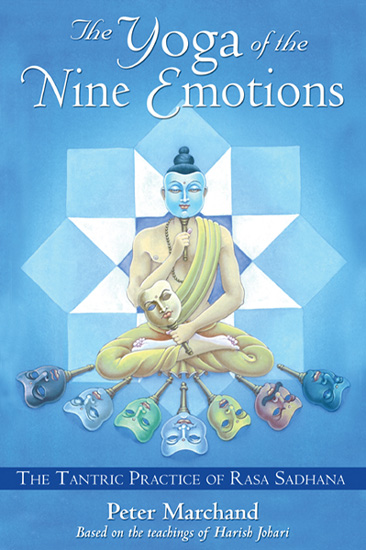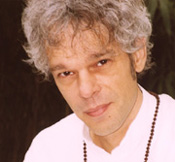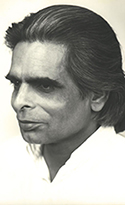Tantric Advaita |
 ISBN: 1-59477-094-8
ISBN: 1-59477-094-8
Quality Paperback
Page Count: 192;
6.00 (width) x 9.00 (height)
Imprint: Destiny Books
Published : 21 April 2006
This book is a complete guide to changing negative emotions and promoting happiness using traditional Tantric and Ayurvedic practices :
>>> Details the 9 Rasas that represent our basic emotions.
>>> Offers emotional fasting exercises (Rasa Sadhana) and daily routines for emotional well-being.
>>> Shows how Rasa Sadhana can be integrated with other yoga practices.
Rasas are the essence of our emotions that exist in both the body and the mind. The Tantric tradition recognizes 9 Rasas that represent our basic emotions: love, joy, wonder, courage, calmness, anger, sadness, fear, and disgust. Those who practice Rasa Sadhana learn to overcome negative emotions in order to pursue better health, enhanced spiritual growth, and enduring happiness. Our emotions are continuously affected by the interplay of our senses, the elements, food, and the life force in our body. In The Yoga of the Nine Emotions, Peter Marchand offers many practical physiological and philosophical tools from Tantric and Ayurvedic traditions that can help readers change their emotional patterns. He explains the nature and purpose of each Rasa and how we can strengthen or weaken one Rasa through another. He also offers Ayurvedic cooking guidelines and daily routines for balancing sensory input and strengthening emotional health, including fasting from negative emotions as well as how to energize positive ones. As we master our emotions through the practice of Rasa Sadhana, we gain true control of our lives and our relationships with others.
REVIEWS
YOGABASICS :
This guide to mastering your emotions through traditional yogic, Tantric and Ayurvedic practices is definitely the most fascinating book that I've read in a long while. The function and nature of nine primary emotions are explored in detail and are explained in relation to yogic philosophy and Ayurvedic principles. The chapters on each emotion are rich with detailed discussions giving insights, understanding, and most importantly effective tools to cultivate positive emotions and reduce the negative ones. Marchand's correlation between the effects of the emotional states to western science and biochemistry is captivating and insightful, and clearly shows the relationship between our emotions and our immune system, sense organs, thoughts, diet and lifestyle. This well-written and well-researched book provides both the information and inspiration to utilize our emotions to promote better health, spiritual growth, and enduring happiness.
Timothy Burgin, www.yogabasics.com.
YANTRATECTURE :
This is a great book that introduces the spiritual practice known as Rasa Sadhana, or the Yoga of the Emotions. Rasa Sadhana is a practice which names the Nine Key Emotions in two categories: agreeable and disagreeable. The premise is to reduce one's need or involvement with the less agreeable emotions of anger, disgust, sadness and fear, and enhance the agreeable emotions of wonder, calmness, love, courage and joy.
Peter Marchand brings this practice to life with practical examples and suggestions to reduce or enhance these emotions. Of course reading the book isn't enough, it takes courage (one of the agreeable emotions) to begin to integrate these practices on a daily basis and reap the very positive and tangible results. However reading about them is the first step, it cultivates awareness and actually I felt remarkable peaceful after reading the chapter on CALM. This book is a must for anyone hoping to bring yogic awareness into one's emotional life, it will save you $$$ on psychotherapy and be an invaluable tool for mastering your emotions within interpersonal relationships, at home, at work and at play.
Sarah Tomlinson, www.yantratecture.com.
GHOSTVILLAGE :
Based on the teachings of the tantric scholar, Harish Johari (1934 - 1999), this appealing look at the emotions which exist in body and mind will find a large reading audience. Essentially, the tantric tradition identifies nine rasas which represent our basic emotions. These nine rasas are love, joy, wonder, courage, calmness, anger, sadness, fear, and disgust.
When a person studies the rasas, that person is able to examine his or her own emotions and develop emotional intelligence when dealing with them. Negative emotions are overcome, which in turn allows for better health, a highly enhanced sense of spiritual growth, and the promise for enduring happiness.
By reading this book, readers will come to understand how tantric and ayurvedic traditions from India can be beneficial for personal usage and development. The book offers guidelines which are helpful, and practical. By gaining a true, genuine control of our emotions, we also gain control of our lives, and the honest relationships we seek to have with other people.
Clearly written, this book is a a fine example of how self-help books should be constructed. The book is honest, straight-forward, and designed to help the reader. For those interested in the practice of Rasa Sadhana, this is the book for them. Peter Marchand is to be congratulated on a fine, clearly written book, one that will be of immense help to many people.
Lee Prosser - leep@ghostvillage.com www.Ghostvillage.com
TIMELESS SPIRIT MAGAZINE :
The Author of 'The Yoga of the Nine Emotions' , Peter Marchand, began his yogic studies in 1983 under Harish Johari, who is often referred to as a 'renaissance man' in the world of yoga. Peter Marchand is now an accomplished author and teaches Rasa Sadhana all over the world. The Yoga of the Nine Emotions, 'Rasa Sadhana', is the practice and study of rasas. Rasas are the essence of emotions. There are nine rasas, Peter explains: Love, Joy, Wonder, Courage, Calmness, Anger, Sadness, Fear and Disgust. Rasa Sadhana involves 'Rasa Fasting': Fasting from, or on, specific emotions for a specified period of time. It is suggested that a person practice only one rasa at a time to give it the true attention it deserves. Some people spend a lifetime (literally) in true Rasa Sadhana: embracing one rasa for their whole lives.
With four sections, this book has interesting information on all aspects of our nine emotions and how our everyday surroundings affect them. Vibrations of sound, colours and shapes, art, and people, all have tremendous affects on our emotions. The author explains how profoundly our emotions affect our body and mind. With a chapter on food, Peter explains how food affects our body and mind deeply, as it is our fuel. He also speaks of the importance of balancing sensory input. Technology is all around us and it is so important to embrace silence with some quiet time when the T.V., radio, computer etc, are not on. Sensory overload causes confusion, it is imperative we give all of our senses a break from time to time. I seriously recommend this book, for the explanation of the nine rasas alone; although, the rest of the book is fantastic as well! I feel I've been introduced to my emotions - this book has really helped me become more aware of them. I've realized each rasa is present in every situation and, that I can use willpower and intuition to recognize all the rasas in any situation, to gain greater awareness. Great clarity is gained when a person can see their emotions clearly, and accept them. When an emotion surfaces, it should be properly assessed, and not suppressed or dwelled upon. Life happens around us and we perceive it. Through this book, Peter Marchand has taught me to, 'Find the one inside that is always watching without being affected.' After reading this book I honestly feel more in touch with myself.
Amanda Bugeaud - https://www.timelessspirit.com/JAN07/review2.shtml
THE BEACON :
A guidebook for working with negative emotions and restoring health using Tantric and Ayurvedic practices. Marchand provides useful findings from Western scientific research into the relationship between neurotransmitters in the brain and emotional well-being, that strike an interesting contrast to the ancient system of Ayurvedic medicine... The practice of Rasa Sadhana can inaugurate a new cycle in the emotional evolution of mankind.
The Beacon, April-June 2007.
LA YOGA, AYURVEDA & HEALTH :
Peter Marchand's new book provides a thorough yet accessible exploration of the often overlooked connection between India 's secular, easthetic and spiritual realities. provides a bridge between the culture's fullest spiritual expressions and the everyday temptations and avoidances that confront the artist, scholar or spiritual practitioner. Marchand keeps one eye on the modern world and the other on traditional Indian values, philosophy, religion and spiritual sciences... Nine Emotions also provides a glimpse into how Indian polytheism, monism and non-dualism may remain completely unaffected by life's most seemingly paradoxical expressions.
Dave Alber, LA Yoga, Ayurveda and Health, May 2007.
CALIFORNIA BOOKWATCH :
Peter Marchand's THE YOGA OF THE NINE EMOTIONS: THE TANTRIC PRACTICE OF RASA SADHANA blends Hinduism spirituality with self-help advise, surveying the Tantric tradition as it relates to the Rasas for emotions: Love, Joy, Under, Courage, Calmness, Anger, Sadness, Fear and Disgust. Learn how to change the emotional patterns using tools from Tantric and Ayurvedic traditions in this unusual link to using spiritual tools for self-help.
Donovan's picks
SYDNEYBOOKQUARTER
So many readers and yogic practitioners have been enriched by the writings of Harish Johari. This book, written by one of his prominent students, is a distillation of Johari's impressive knowl-edge, and constitutes a complete guide to improving one's life through tantric and ayurvedic practices. Marchand's understanding of the nine rasas, or emotions - which are based on ancient tantric teaching - is impressively profound and this intensely practical book is an essential addition to the library of anyone interested in following a truly yogic lifestyle.
Tim Graham (Editor)
TABLE OF CONTENTS
Acknowledgments
Introduction
PART 1: RASA SADHANA
1.1 Nine Rasas
Desirable and Less Desirable Rasas
Rasa Sadhana
1.2 Rasas in the Body
Rasas and Elements
Rasas and Doshas
Rasas and Gunas
Food, Senses, and Rasas
Rasas, Prana, and Breath
Rasas and Chakras
1.3 Body Emotions in Western Science
The Functioning of the Brain
Information Molecules
Drugs, Senses, and Food
Emotional Patterns
1.4. Indian Philosophy and Rasas
PART 2: THE NINE RASAS
2.1 Shringara: Love
2.2 Hasya: Joy
2.3 Adbhuta: Wonder
2.4. Shanta: Calmness
2.5 Raudra: Anger
2.6 Veera: Courage
2.7 Karuna: Sadness
2.8 Bhayanaka: Fear
2.9 Vibhatsa: Disgust
PART 3: WORKING WITH OUR RASAS
3.1 Mastering Emotions
The Great Taboo
Choose Sadness or Joy
Rasas of Preference
3.2 Rasa Sadhana
Reprogramming the Brain
Setting Objectives
Setting the Rules
Thoughts, Words, and Actions
Lifelong Rasa Sadhana
3.3 Balancing Sensory Input
Avoiding Confusion
Sound
Sight
Smell
Touch
Taste
Beyond the Senses
3.4. Cooking Emotions
The Rasa Dhatu
Balanced Ayurvedic Foods
Avoiding Emotionally Toxic Foods
Digestibility of Foods
Mood Foods
Other Aspects
3.5 Daily Routines
Tuning into Natural Cycles
Waking Up
Bathing
Puja
Meals
Exercise
Hobbies
Sleep
3.6 Emotional Emergencies
PART 4: OUR RASAS IN SOCIETY
4.1 The Emotional Evolution of Humankind
4.2 Rasas and Western Science
Effects of Emotions on Health
More Research Needed
Faulty Interpretation
4.3 Rasas, Religion, Spirituality, and Yoga
Rasa Yoga
Yoga and Rasas
Rasas in Yoga Teaching
Religion and Spirituality
4.4. Power to the Artists
Two Branches of Rasa Knowledge
Rasa and Bhava
Rasas, Ragas, and Dance
Objectives of Indian Art
Rules of Indian Art
Modern Art
4.5 Social Work and Politics
Rasas and Castes
Rasas and Social Work
Rasas and Politics
4.6 Mood Marketing
Rasas in Marketing
Mood Products
4.7 Rasas in Therapy
Conclusion
Sanskrit Glossary
References
Index
 Leela is the ancient vedic name for the theater of life. Life in all its forms is an illusion behind which we can find the ultimate truth of pure Being. Yet life is also a divine theater, a spiritual game played by us, the actors. Yoga allows us to hold on to the bliss of truth while playing the game. And also this yoga is a game, which we can only take seriously if we do not take ourselves and this game too seriously. That is the meaning of Leela Yoga, nothing more, nothing less. So, Leela Yoga is a vision on yoga and also a name for a simple organisation that allows me to bring this vision into practice... more about Leela Yoga & Peter Marchand
Leela is the ancient vedic name for the theater of life. Life in all its forms is an illusion behind which we can find the ultimate truth of pure Being. Yet life is also a divine theater, a spiritual game played by us, the actors. Yoga allows us to hold on to the bliss of truth while playing the game. And also this yoga is a game, which we can only take seriously if we do not take ourselves and this game too seriously. That is the meaning of Leela Yoga, nothing more, nothing less. So, Leela Yoga is a vision on yoga and also a name for a simple organisation that allows me to bring this vision into practice... more about Leela Yoga & Peter Marchand
International Leela Yoga Facebook Group
Belgium : www.leela-yoga.be
New book : www.tantricadvaita.org
Harish Johari students sangha : www.sanatansociety.org
 |
in sweet memory of Harish Johari |
As the destination is the same for all, it is easy to make the error of assuming that the path must be just as universal.
The attachment that happens in the pursuit of happiness is the main source of unhappiness.
Don't think of going somewhere, because this somewhere will come along with you wherever you go, as you are already there.
Yoga requires unity between enjoyment and suffering, between bhoga and yoga, even between attachment and detachment.
How can anyone be "good" without a choice between good and bad?
While the mind creates the illusion of the universe through the senses, the intellect creates the illusion of understanding it.
When our day has been entirely ego-centered, then our meditation will probably have similar poor quality.
When the focus on the self is held strongly enough, the flow of kundalini energy happens on its own, naturally.
Tiptoe inside, don't make a sound, don't scare away that which cannot be found.
Enlightenment is nothing more or less than the final level of the game of life.